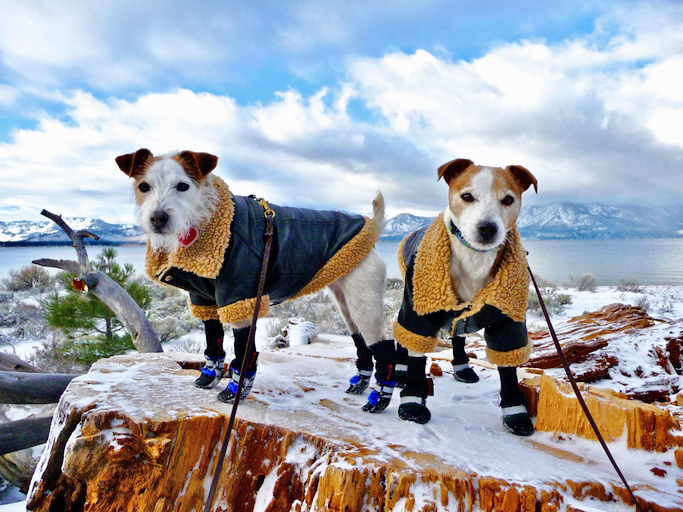Does your dog need a winter coat? If he spends most of the day indoors, has a thin, short coat, and shivers when it’s chilly, a cold-weather jacket can help him adjust to winter temperatures for cold-weather walks – or even just going outdoors to potty. Make that a raincoat if you live where it’s cold and wet. Most dog raincoats have two layers, a top one for repelling water and an insulating layer for warmth.
All kinds of keep-warm sweaters, vests, coats, jackets, and even whole-body suits for dogs are sold in pet supply stores, department stores, and online. Consider how active your dog will be outdoors and what garment shape, design, and fabric weight will work best. Washable blends of wool or polyester fleece (what “polar fleece” is made of) are popular because they’re comfortable for most dogs and easy to care for.
Before they became canine fashion accessories, jackets were designed for working dogs who spent hours outdoors – and may even swim! – in rain, snow, ice, and cold winds. Most jackets or vests for sporting and hunting dogs who need insulation when wet are made of neoprene – the same material used to make diving wetsuits for humans. If your dog joins you for hours of wet outdoor walks, search for a vest or jacket made with neoprene.
Measure For a Good Fit
Use a tape measure (the fabric kind used for sewing) to measure for a sweater, vest, coat, or jacket that will cover the dog’s chest and back. With the dog standing still with head up, measure:
- Neck circumference, as for a collar.
- From the collar down the spine to the base of the tail.
- Around the chest directly behind the front legs.
Compare measurements to the manufacturer’s size chart. Some sellers list sizes based on your dog’s breed.
Dog Boots and Socks
Ice and snow, and rock salt and other ice-melting chemicals are hard on a dog’s feet, so consider keeping them warm and dry with the right footwear. The best dog boots are flexible, water-resistant, grip the ground with textured soles, and have adjustable Velcro straps. Popular brands include Kurgo, SaltSox, and Muttluks. Check size guidelines and measure before ordering. Most dogs dislike booties at first, so introduce them indoors for short periods or start by having your dog get used to indoor dog socks, which are designed with a non-skid surface to help older or injured dogs improve mobility.
Dog Snoods for Extra Winter Coverage
A snood looks like an extended hat that covers the head, ears, and neck, protecting them from wind, rain, and cold weather. One source is The Snood Factory, which makes snoods especially for breeds with long hair and long ears (but which are helpful winter wear for any dog at risk of frostbite!) or search online for dog snoods.
Dog Heating Pads
Heated dog beds, warming pads, and self-heating (non-electric) pads can help an arthritic, elderly, or simply cold dog or puppy feel comfortable, indoors or out. The best electric pads have chew-proof cords, timers that shut off automatically (or mechanisms that heat only when weighted by a dog), washable covers, and a heat limit that protects dogs against overheating. They come in different sizes and are clearly labeled for indoor or outdoor use. See K&H Pet Products or search Amazon, Chewy, and other suppliers for Riogoo, Frisco, Aspen, and similar brands.






I got Diana pawPrints used to booties in one afternoon. We use them for scentwork as there are certain floor surfaces she does not like to walk on and I have no idea what we will encounter. They are just part of her “working uniform” now. I used hot dogs and introduced them slowly over the course of half an hour and then did that a few hours apart, staring with sniffing and touching, then the rear feet first, then the front feet. I did the same the next day, only a bit faster. She was very eager for the hot dogs. By the third day she was eager to get them on immediately. You can guess why.
Snow and ice is not a problem in our area. Even though she doesn’t have much hair to speak of, she’s fine outside in our mild winters. Freyja has no problem at all, being the hairy husky mix she is.
I have always wanted to knit them little hats with scarves but they’re not needed and not sure they would love them.
I absolutely LOVE the coats on your dogs in the picture, would you mind sharing where you got them please?